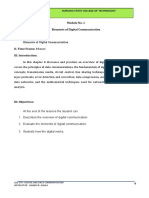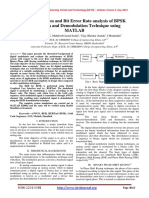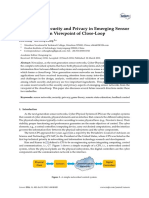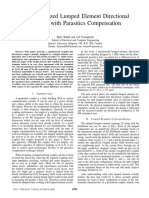Module-5 Introduction To Electronics Communication. Notes
Module-5 Introduction To Electronics Communication. Notes
Uploaded by
Darshan GowdaCopyright:
Available Formats
Module-5 Introduction To Electronics Communication. Notes
Module-5 Introduction To Electronics Communication. Notes
Uploaded by
Darshan GowdaOriginal Title
Copyright
Available Formats
Share this document
Did you find this document useful?
Is this content inappropriate?
Copyright:
Available Formats
Module-5 Introduction To Electronics Communication. Notes
Module-5 Introduction To Electronics Communication. Notes
Uploaded by
Darshan GowdaCopyright:
Available Formats
||Jai Sri Gurudev ||
Sri Adichunchanagiri Shikshana Trust®
SJB INSTITUTE OF TECHNOLOGY
Accredited by NBA & NAAC with ‘A’ Grade
No. 67, BGS Health & Education City, Dr. Vishnuvardhan Road
Kengeri, Bangalore – 560 060
Department of Electronics & Communication
Engineering
Introduction to Electronics Communication (BESCK104C/204C)
MODULE – 5
Analog Communication Schemes & Digital Modulation Schemes
Notes (as per VTU Syllabus)
I SEMESTER – B. E
Academic Year: 2022 – 2023 (ODD)
Course Coordinator: Darshan B D
Designation: Assistant Professor
Introduction to Electronics & Communication
Modern communication system scheme
Information source and input transducer
Dept. of ECE/SJBIT Page 2
Introduction to Electronics & Communication
Dept. of ECE/SJBIT Page 3
Introduction to Electronics & Communication
Dept. of ECE/SJBIT Page 4
Introduction to Electronics & Communication
Transmitter:
Dept. of ECE/SJBIT Page 5
Introduction to Electronics & Communication
Dept. of ECE/SJBIT Page 6
Introduction to Electronics & Communication
Channel or medium
Dept. of ECE/SJBIT Page 7
Introduction to Electronics & Communication
Noise
Noise and Noise Figure (F)
One can define the SNR as the ratio of the signal power to the noise power at a point in the
Dept. of ECE/SJBIT Page 8
Introduction to Electronics & Communication
Receiver
Dept. of ECE/SJBIT Page 9
Introduction to Electronics & Communication
Multiplexing
Dept. of ECE/SJBIT Page 10
Introduction to Electronics & Communication
Types of Communication System
Dept. of ECE/SJBIT Page 11
Introduction to Electronics & Communication
Types of Modulation
Amplitude Modulation
Amplitude Modulation Amplitude Modulation is the changing the amplitude of the carrier signal with
respect to the instantaneous change in message signal. The amplitude modulated wave form, its envelope,
and its frequency spectrum bandwidth. Fig (a) Sinusoidal modulation signal (b)High frequency carrier (c)
AM signal.
Modulation Index, m=M/A
Where:
A= the carrier amplitude.
M = the modulation amplitude and is the peak change in the RF amplitude from its un-modulated value.
Dept. of ECE/SJBIT Page 12
Introduction to Electronics & Communication
Using the equation above a modulation index of 0.75 means that the signal will increase by a factor of
0.75 and decrease to 0.25 of its original level.
A modulation index of 1 is the maximum level of modulation that can normally be applied and occurs
when the envelope increases by a factor of 1, i.e., twice the steady state value, and falls to zero.
FM, Phase Modulation, Pulse Modulation, PAM, PWM, PPM, PCM. Concept of Radio wave
propagation
Dept. of ECE/SJBIT Page 13
Introduction to Electronics & Communication
Dept. of ECE/SJBIT Page 14
Introduction to Electronics & Communication
Dept. of ECE/SJBIT Page 15
Introduction to Electronics & Communication
Dept. of ECE/SJBIT Page 16
Introduction to Electronics & Communication
Dept. of ECE/SJBIT Page 17
Introduction to Electronics & Communication
Dept. of ECE/SJBIT Page 18
Introduction to Electronics & Communication
Dept. of ECE/SJBIT Page 19
Introduction to Electronics & Communication
Digital Modulation Schemes:
Advantages of Digital Communication Over Analog Communication
Advantages of Digital Communication
As the signals are digitized, there are many advantages of digital communication over analog
communication, such as
• The effect of distortion, noise, and interference is much less in digital signals as they are less
affected.
• Digital circuits are more reliable.
• Digital circuits are easy to design and cheaper than analog circuits.
• The hardware implementation in digital circuits, is more flexible than analog.
• The occurrence of cross-talk is very rare in digital communication.
• The signal is un-altered as the pulse needs a high disturbance to alter its properties, which is very
difficult.
• Signal processing functions such as encryption and compression are employed in digital circuits to
maintain the secrecy of the information.
• The probability of error occurrence is reduced by employing error detecting and error correcting
codes.
• Spread spectrum technique is used to avoid signal jamming.
• Combining digital signals using Time Division Multiplexing TDM is easier than combining analog
signals using Frequency Division Multiplexing FDM.
• The configuring process of digital signals is easier than analog signals.
• Digital signals can be saved and retrieved more conveniently than analog signals.
• Many of the digital circuits have almost common encoding techniques and hence similar devices
can be used for a number of purposes.
• The capacity of the channel is effectively utilized by digital signals.
Dept. of ECE/SJBIT Page 20
Introduction to Electronics & Communication
Radio Signal Transmission
Dept. of ECE/SJBIT Page 21
Introduction to Electronics & Communication
Dept. of ECE/SJBIT Page 22
Introduction to Electronics & Communication
ASK
The short form of Amplitude Shift Keying is referred as ASK. It is the digital modulation
technique. In this technique, amplitude of the RF carrier is varied in accordance with
baseband digital input signal. The figure depicts operation of ASK modulation. As
shown in the figure, binary 1 will be represented by carrier signal with some amplitude
while binary 0 will be represented by carrier of zero amplitude(i.e. no carrier).
ASK modulation can be represented by following equation:
s(t) = A2* cos(2*π*fc*t) for Binary Logic-1
s(t) = A1* cos(2*π*fc*t) for Binary Logic-0
Here A2>A1
Signalling used is ON-OFF signalling.
Bandwidth requirement for ASK is:
BW = 2/Tb = 2*Rb
Often in ASK modulation, binary-1 is represented by carrier with amplitude-A2 and
binary-0 is represented by carrier with amplitude-A1.
• In ASK probability of error (Pe) is high and SNR is less.
• It has lowest noise immunity against noise.
• ASK is a bandwidth efficient system but it has lower power efficiency.
Dept. of ECE/SJBIT Page 23
Introduction to Electronics & Communication
FSK
The short form of Frequency Shift Keying is referred as FSK. It is also digital
modulation technique. In this technique, frequency of the RF carrier is varied in
accodance with baseband digital input. The figure depicts the FSK modulation. As
shown, binary 1 and 0 is represented by two different carrier frequencies. Figure
depicts that binary 1 is represented by high frequency 'f1' and binary 0 is represented
by low frequency 'f2'.
Binary FSK can be represented by following equation:
s(t) = A* cos(2*π*f1*t) for Binary 1
s(t) = A* cos(2*π*f2*t) for Binary 0
In FSK modulation, NRZ signalling method is used. Bandwidth requirement in case of
FSK is:
BW = 2*Rb + (f1-f2)
• In case of FSK, Pe is less and SNR is high.
• This technique is widely employed in modem design and development.
• It has increased immunity to noise but requires larger bandwidth compare to other
modulation types.
Dept. of ECE/SJBIT Page 24
Introduction to Electronics & Communication
PSK
The short form of Phase Shift Keying is referred as PSK. It is digital modulation
technique where in phase of the RF carrier is changed based on digital input. Figure
depicts Binary Phase Shift Keying modulation type of PSK. As shown in the figure,
Binary 1 is represented by 180 degree phase of the carrier and binary 0 is represented
by 0 degree phase of the RF carrier.
Binary PSK can be represented by following equation :
If s(t) = A*cos(2*π*fc*t) for Binary 1 than
s(t) = A*cos(2*π*fc*t + π) for Binary 0
In PSK modulation, NRZ signalling is used. Bandwidth requirement for PSK is:
BW = 2 * Rb = 2 * Bit rate
• In case of PSK probability of error is less. SNR is high.
• It is a power efficient system but it has lower bandwidth efficiency.
• PSK modulation is widely used in wireless transmission.
• The variants of basic PSK and ASK modulations are QAM, 16-QAM, 64-QAM and so
on.
Dept. of ECE/SJBIT Page 25
Introduction to Electronics & Communication
Multiple Access Technique
Dept. of ECE/SJBIT Page 26
Introduction to Electronics & Communication
Multiple Access Techniques
In wireless communication systems, it is often desirable to allow the subscriber to send
information simultaneously from the mobile station to the base station while receiving information
from the base station to the mobile station.
A cellular system divides any given area into cells where a mobile unit in each cell communicates
with a base station. The main aim in the cellular system design is to be able to increase the
capacity of the channel, i.e., to handle as many calls as possible in a given bandwidth with a
sufficient level of quality of service.
There are several different ways to allow access to the channel. These includes mainly the
following −
• Frequency division multiple-access (FDMA)
• Time division multiple-access (TDMA)
• Code division multiple-access (CDMA)
• Space division multiple access (SDMA)
Depending on how the available bandwidth is allocated to the users, these techniques can be
classified as narrowband and wideband systems.
Narrowband Systems
Systems operating with channels substantially narrower than the coherence bandwidth are
called as Narrow band systems. Narrow band TDMA allows users to use the same channel but
allocates a unique time slot to each user on the channel, thus separating a small number of
users in time on a single channel.
Wideband Systems
In wideband systems, the transmission bandwidth of a single channel is much larger than the
coherence bandwidth of the channel. Thus, multipath fading doesn’t greatly affect the received
signal within a wideband channel, and frequency selective fades occur only in a small fraction
of the signal bandwidth.
Frequency Division Multiple Access (FDMA)
FDMA is the basic technology for advanced mobile phone services. The features of FDMA are
as follows.
• FDMA allots a different sub-band of frequency to each different user to access the network.
• If FDMA is not in use, the channel is left idle instead of allotting to the other users.
• FDMA is implemented in Narrowband systems and it is less complex than TDMA.
• Tight filtering is done here to reduce adjacent channel interference.
• The base station BS and mobile station MS, transmit and receive simultaneously and
continuously in FDMA.
Dept. of ECE/SJBIT Page 27
Introduction to Electronics & Communication
Time Division Multiple Access (TDMA)
In the cases where continuous transmission is not required, there TDMA is used instead of
FDMA. The features of TDMA include the following.
• TDMA shares a single carrier frequency with several users where each users makes use of non-
overlapping time slots.
• Data transmission in TDMA is not continuous, but occurs in bursts. Hence handsoff process is
simpler.
• TDMA uses different time slots for transmission and reception thus duplexers are not required.
• TDMA has an advantage that is possible to allocate different numbers of time slots per frame to
different users.
• Bandwidth can be supplied on demand to different users by concatenating or reassigning time
slot based on priority.
Code Division Multiple Access (CDMA)
Code division multiple access technique is an example of multiple access where several
transmitters use a single channel to send information simultaneously. Its features are as follows.
• In CDMA every user uses the full available spectrum instead of getting allotted by separate
frequency.
• CDMA is much recommended for voice and data communications.
• While multiple codes occupy the same channel in CDMA, the users having same code can
communicate with each other.
• CDMA offers more air-space capacity than TDMA.
• The hands-off between base stations is very well handled by CDMA.
Space Division Multiple Access (SDMA)
Space division multiple access or spatial division multiple access is a technique which is MIMO
(multiple-input multiple-output) architecture and used mostly in wireless and satellite
communication. It has the following features.
• All users can communicate at the same time using the same channel.
• SDMA is completely free from interference.
• A single satellite can communicate with more satellites receivers of the same frequency.
• The directional spot-beam antennas are used and hence the base station in SDMA, can track a
moving user.
• Controls the radiated energy for each user in space.
Dept. of ECE/SJBIT Page 28
You might also like
- Analog and Digital Modulation Formats of Optical Fiber Communication Within and BeyondNo ratings yetAnalog and Digital Modulation Formats of Optical Fiber Communication Within and Beyond19 pages
- Digitalmicrowavecommunicationprinciples 131014163928 Phpapp02No ratings yetDigitalmicrowavecommunicationprinciples 131014163928 Phpapp02113 pages
- BER of OFDM System Using Concatenated Forward Error Correcting Codes (FEC) Over Nakagami-M Fading Channel100% (1)BER of OFDM System Using Concatenated Forward Error Correcting Codes (FEC) Over Nakagami-M Fading Channel5 pages
- Data and Digital Communications Module 1No ratings yetData and Digital Communications Module 19 pages
- Implementation and Bit Error Rate Analysis of BPSK Modulation and Demodulation Technique Using MatlabNo ratings yetImplementation and Bit Error Rate Analysis of BPSK Modulation and Demodulation Technique Using Matlab5 pages
- Best Modulation Technique and Most Efficient Carrier Number For Getting Maximum SNR and Minimum Ber For Ofdm Generated Signal Over Rayleigh DistributionNo ratings yetBest Modulation Technique and Most Efficient Carrier Number For Getting Maximum SNR and Minimum Ber For Ofdm Generated Signal Over Rayleigh Distribution8 pages
- Unit Iii - Part-A: Course Material (Question Bank)No ratings yetUnit Iii - Part-A: Course Material (Question Bank)5 pages
- Implementation and Bit Error Rate Analysis of BPSK Modulation and Demodulation Technique Using MATLAB100% (1)Implementation and Bit Error Rate Analysis of BPSK Modulation and Demodulation Technique Using MATLAB5 pages
- WR - BT02 - E1 - 1 WCDMA Wireless Principle 49No ratings yetWR - BT02 - E1 - 1 WCDMA Wireless Principle 4949 pages
- Digital Transmission Systems: 4.1 Design of Intensity Modulated Direct Detection (Imdd) LinksNo ratings yetDigital Transmission Systems: 4.1 Design of Intensity Modulated Direct Detection (Imdd) Links23 pages
- Next Generation SDTV&HDTV Distribution System: Scopus Network Technologies, IsraelNo ratings yetNext Generation SDTV&HDTV Distribution System: Scopus Network Technologies, Israel8 pages
- Bit-Error-Rate (BER) For Modulation Technique Using Software Defined RadioNo ratings yetBit-Error-Rate (BER) For Modulation Technique Using Software Defined Radio3 pages
- BER Performance of OFDM-BPSK,-QPSK,-QAM Over AWGN Channel Using Forward Error Correcting CodeNo ratings yetBER Performance of OFDM-BPSK,-QPSK,-QAM Over AWGN Channel Using Forward Error Correcting Code6 pages
- Module 4 Basic Electronics Notes 2021pdfNo ratings yetModule 4 Basic Electronics Notes 2021pdf33 pages
- Nigerian Communications Commission Grant PresentationNo ratings yetNigerian Communications Commission Grant Presentation69 pages
- 22EC403 ANALOG AND DIGITAL COMMUNICATION -UNIT-IV - PART-ANo ratings yet22EC403 ANALOG AND DIGITAL COMMUNICATION -UNIT-IV - PART-A51 pages
- Signal Integrity: From High-Speed to Radiofrequency ApplicationsFrom EverandSignal Integrity: From High-Speed to Radiofrequency ApplicationsNo ratings yet
- BICSI RCDD Registered Communications Distribution Designer Exam Prep And Dumps RCDD-001 Exam Guidebook Updated QuestionsFrom EverandBICSI RCDD Registered Communications Distribution Designer Exam Prep And Dumps RCDD-001 Exam Guidebook Updated QuestionsNo ratings yet
- RF Analog Impairments Modeling for Communication Systems Simulation: Application to OFDM-based TransceiversFrom EverandRF Analog Impairments Modeling for Communication Systems Simulation: Application to OFDM-based TransceiversNo ratings yet
- IA-1-SCHEME Introduction To Electronics Engg.No ratings yetIA-1-SCHEME Introduction To Electronics Engg.8 pages
- Module-1 Introduction To Electronics Engg. Notes100% (1)Module-1 Introduction To Electronics Engg. Notes26 pages
- Module-4 Introduction To Electronics Engg. Notes0% (1)Module-4 Introduction To Electronics Engg. Notes20 pages
- Sensors: A Trust-Based Adaptive Probability Marking and Storage Traceback Scheme For WsnsNo ratings yetSensors: A Trust-Based Adaptive Probability Marking and Storage Traceback Scheme For Wsns25 pages
- Sensors: A Survey On Security and Privacy in Emerging Sensor Networks: From Viewpoint of Close-LoopNo ratings yetSensors: A Survey On Security and Privacy in Emerging Sensor Networks: From Viewpoint of Close-Loop16 pages
- Wireless and Internet of Things (Iot) SecurityNo ratings yetWireless and Internet of Things (Iot) Security57 pages
- Explain in Short Six Characteritics of Transmission Media. - Computer Science 2No ratings yetExplain in Short Six Characteritics of Transmission Media. - Computer Science 21 page
- New Shopping List MBTS - 13 Sept 2018 Share Vendor CME. (Ori) Wo PriceNo ratings yetNew Shopping List MBTS - 13 Sept 2018 Share Vendor CME. (Ori) Wo Price13 pages
- GPS 175/GNX 375/GNC 355 Part 23 Aml STC Maintenance Manual: With Instructions For Continued Airworthiness STC SA02636SENo ratings yetGPS 175/GNX 375/GNC 355 Part 23 Aml STC Maintenance Manual: With Instructions For Continued Airworthiness STC SA02636SE74 pages
- Vehicle Relay Attack Avoidance Methods Using RF SiNo ratings yetVehicle Relay Attack Avoidance Methods Using RF Si5 pages
- A Miniaturized Lumped Element Directional CouplerNo ratings yetA Miniaturized Lumped Element Directional Coupler4 pages
- Operation Guide 3143: Getting AcquaintedNo ratings yetOperation Guide 3143: Getting Acquainted12 pages
- Multiple Choice Questions and Answers On Amplitude Modulation100% (1)Multiple Choice Questions and Answers On Amplitude Modulation22 pages
- Lecture Five Noise in Communication SystNo ratings yetLecture Five Noise in Communication Syst5 pages
- APT-AWG-REP-112 - APT Report On Mitigation Measures To Improve Sharing and Compatibility Between 4G-LTE and 5G-NR Systems and Other Systems... 3300 - 4200 MHZNo ratings yetAPT-AWG-REP-112 - APT Report On Mitigation Measures To Improve Sharing and Compatibility Between 4G-LTE and 5G-NR Systems and Other Systems... 3300 - 4200 MHZ52 pages
- Antenna Diversity: From Wikipedia, The Free EncyclopediaNo ratings yetAntenna Diversity: From Wikipedia, The Free Encyclopedia5 pages
- Settings, Processes, Methods, and Tools in Communication100% (1)Settings, Processes, Methods, and Tools in Communication4 pages
- Analog and Digital Modulation Formats of Optical Fiber Communication Within and BeyondAnalog and Digital Modulation Formats of Optical Fiber Communication Within and Beyond
- Digitalmicrowavecommunicationprinciples 131014163928 Phpapp02Digitalmicrowavecommunicationprinciples 131014163928 Phpapp02
- BER of OFDM System Using Concatenated Forward Error Correcting Codes (FEC) Over Nakagami-M Fading ChannelBER of OFDM System Using Concatenated Forward Error Correcting Codes (FEC) Over Nakagami-M Fading Channel
- Implementation and Bit Error Rate Analysis of BPSK Modulation and Demodulation Technique Using MatlabImplementation and Bit Error Rate Analysis of BPSK Modulation and Demodulation Technique Using Matlab
- Best Modulation Technique and Most Efficient Carrier Number For Getting Maximum SNR and Minimum Ber For Ofdm Generated Signal Over Rayleigh DistributionBest Modulation Technique and Most Efficient Carrier Number For Getting Maximum SNR and Minimum Ber For Ofdm Generated Signal Over Rayleigh Distribution
- Unit Iii - Part-A: Course Material (Question Bank)Unit Iii - Part-A: Course Material (Question Bank)
- Implementation and Bit Error Rate Analysis of BPSK Modulation and Demodulation Technique Using MATLABImplementation and Bit Error Rate Analysis of BPSK Modulation and Demodulation Technique Using MATLAB
- Digital Transmission Systems: 4.1 Design of Intensity Modulated Direct Detection (Imdd) LinksDigital Transmission Systems: 4.1 Design of Intensity Modulated Direct Detection (Imdd) Links
- Next Generation SDTV&HDTV Distribution System: Scopus Network Technologies, IsraelNext Generation SDTV&HDTV Distribution System: Scopus Network Technologies, Israel
- Bit-Error-Rate (BER) For Modulation Technique Using Software Defined RadioBit-Error-Rate (BER) For Modulation Technique Using Software Defined Radio
- BER Performance of OFDM-BPSK,-QPSK,-QAM Over AWGN Channel Using Forward Error Correcting CodeBER Performance of OFDM-BPSK,-QPSK,-QAM Over AWGN Channel Using Forward Error Correcting Code
- Nigerian Communications Commission Grant PresentationNigerian Communications Commission Grant Presentation
- 22EC403 ANALOG AND DIGITAL COMMUNICATION -UNIT-IV - PART-A22EC403 ANALOG AND DIGITAL COMMUNICATION -UNIT-IV - PART-A
- Signal Integrity: From High-Speed to Radiofrequency ApplicationsFrom EverandSignal Integrity: From High-Speed to Radiofrequency Applications
- BICSI RCDD Registered Communications Distribution Designer Exam Prep And Dumps RCDD-001 Exam Guidebook Updated QuestionsFrom EverandBICSI RCDD Registered Communications Distribution Designer Exam Prep And Dumps RCDD-001 Exam Guidebook Updated Questions
- Learn Amateur Radio Electronics on Your SmartphoneFrom EverandLearn Amateur Radio Electronics on Your Smartphone
- RF Analog Impairments Modeling for Communication Systems Simulation: Application to OFDM-based TransceiversFrom EverandRF Analog Impairments Modeling for Communication Systems Simulation: Application to OFDM-based Transceivers
- Sensors: A Trust-Based Adaptive Probability Marking and Storage Traceback Scheme For WsnsSensors: A Trust-Based Adaptive Probability Marking and Storage Traceback Scheme For Wsns
- Sensors: A Survey On Security and Privacy in Emerging Sensor Networks: From Viewpoint of Close-LoopSensors: A Survey On Security and Privacy in Emerging Sensor Networks: From Viewpoint of Close-Loop
- Explain in Short Six Characteritics of Transmission Media. - Computer Science 2Explain in Short Six Characteritics of Transmission Media. - Computer Science 2
- New Shopping List MBTS - 13 Sept 2018 Share Vendor CME. (Ori) Wo PriceNew Shopping List MBTS - 13 Sept 2018 Share Vendor CME. (Ori) Wo Price
- GPS 175/GNX 375/GNC 355 Part 23 Aml STC Maintenance Manual: With Instructions For Continued Airworthiness STC SA02636SEGPS 175/GNX 375/GNC 355 Part 23 Aml STC Maintenance Manual: With Instructions For Continued Airworthiness STC SA02636SE
- Vehicle Relay Attack Avoidance Methods Using RF SiVehicle Relay Attack Avoidance Methods Using RF Si
- Multiple Choice Questions and Answers On Amplitude ModulationMultiple Choice Questions and Answers On Amplitude Modulation
- APT-AWG-REP-112 - APT Report On Mitigation Measures To Improve Sharing and Compatibility Between 4G-LTE and 5G-NR Systems and Other Systems... 3300 - 4200 MHZAPT-AWG-REP-112 - APT Report On Mitigation Measures To Improve Sharing and Compatibility Between 4G-LTE and 5G-NR Systems and Other Systems... 3300 - 4200 MHZ
- Antenna Diversity: From Wikipedia, The Free EncyclopediaAntenna Diversity: From Wikipedia, The Free Encyclopedia
- Settings, Processes, Methods, and Tools in CommunicationSettings, Processes, Methods, and Tools in Communication
































































































